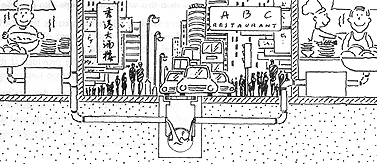Grease and Oil Wastes - Problems and Solutions
A grease trap is a device used for removing oil and grease from wastewaters. Grease traps perform this function very well, provided they are constructed and maintained properly.
Grease and oil that is allowed to enter the sewer system causes problems by separating from the wastewater and accumulating on the inside of sewer pipes. Over time, these deposits get larger as more grease and other solid material builds up. Grease deposits reduce the capacity of sewer pipes and cause sewage overflows, offensive odour and an unhealthy environment. The cleaning of grease deposits from sewers is difficult and can be dangerous and is carried out at considerable cost.
All restaurants and food processing factories are required to install grease traps so that greasy materials will be separated from wastewaters before passing to communal sewers. Restaurants and the food processing industry are the main sources of greasy waste and therefore it is very important that the grease traps used at these establishments are effective in removing grease from wastewater before it passes to the sewer system.
In many areas of Hong Kong, there are limits set by the Water Pollution Control Ordinance on the amount of grease and oil that can be allowed to pass to sewer. Grease traps are therefore very important as they assist you in conforming to these limits.
It is YOUR RESPONSIBILITY as a discharger of greasy wastes to ensure that:
- Grease traps are properly designed and constructed so as to effectively remove greasy materials from your kitchen wastewater before discharge to the sewer system.
- Your grease trap is properly maintained so that it can continue to function as an effective grease removal device and so that kitchen hygiene is preserved.
- Material removed from a grease trap is handled and disposed of properly in order to maintain kitchen hygiene and protect Hong Kong's environment.



